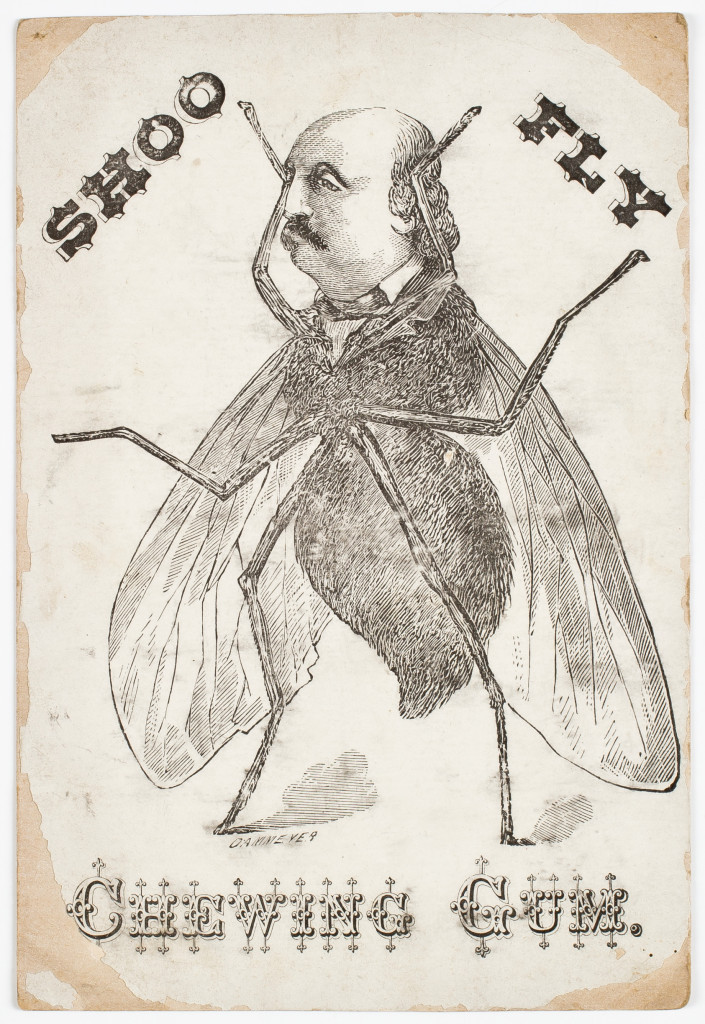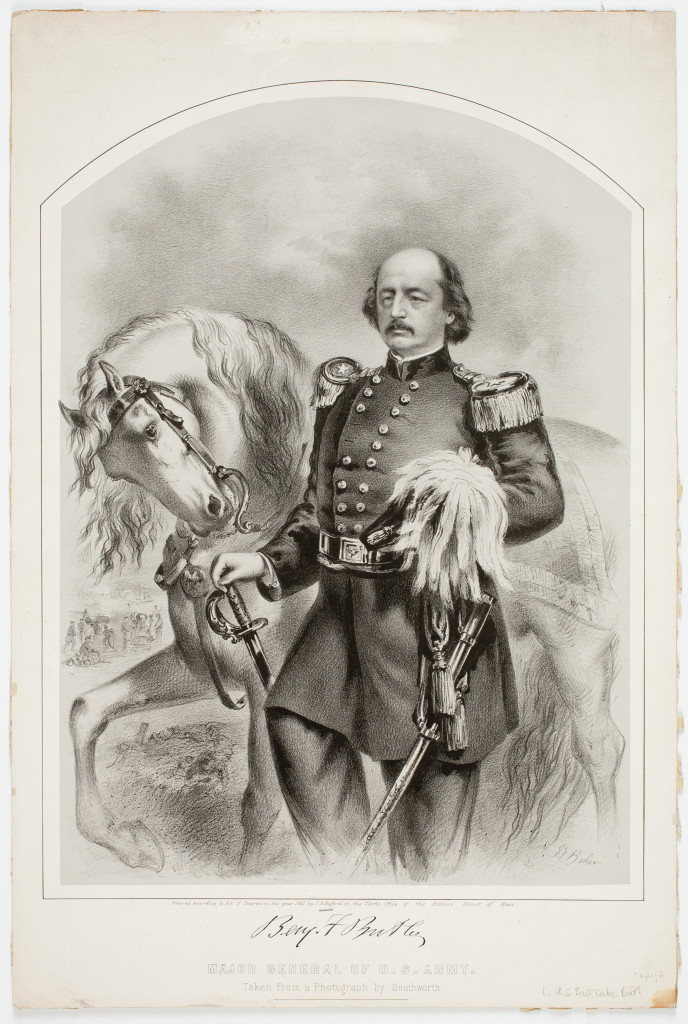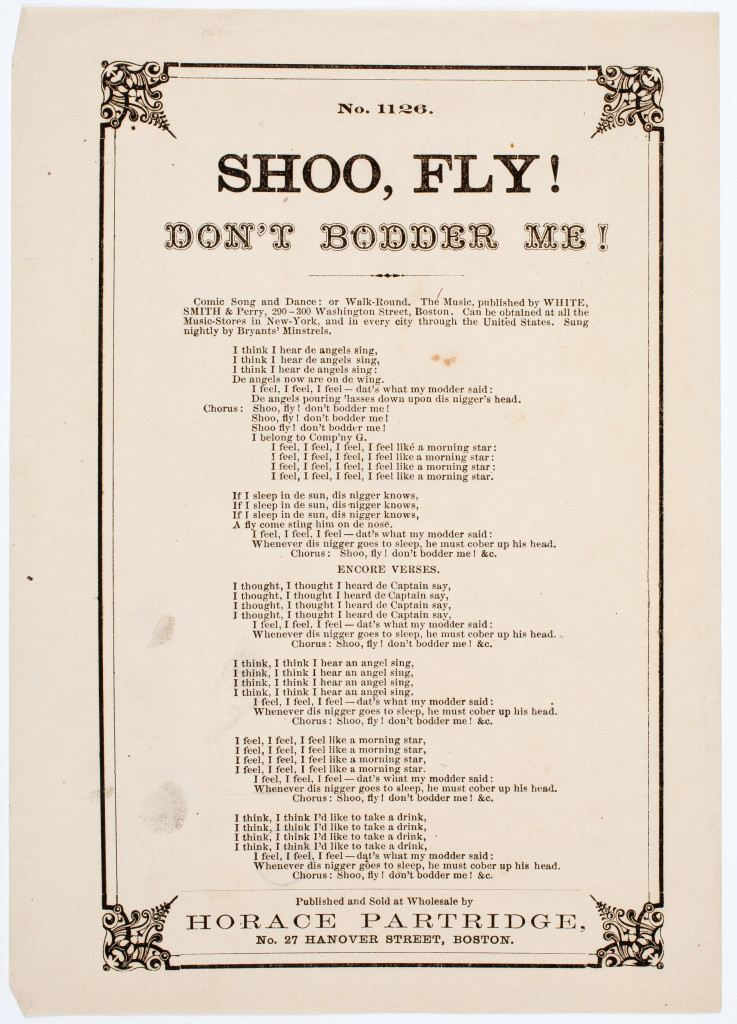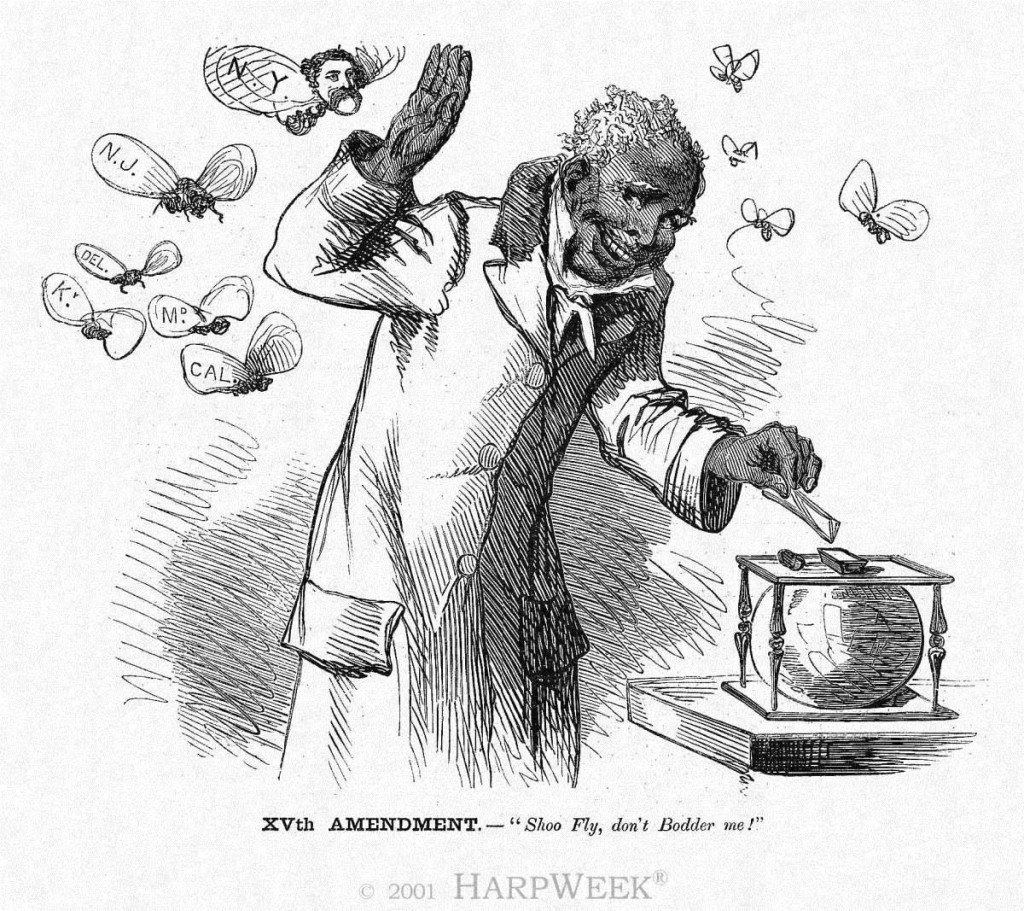 This past winter, while hunting in the stacks for a trade card for a reader, I spotted this intriguing advertisement for chewing gum. As editor of the Society’s Instagram account, I had been participating in an event called #bugginout, which featured posts by libraries around the world focused on illustrations of anthropomorphic insects. These posts had been appearing for a few weeks, every Wednesday, and all of the participants were amazed at how much material we were finding in our collections. I thought immediately of using the Shoo Fly trade card for #bugginout, but first I had to do some research. Why, I thought, was Benjamin Butler’s head on the body of a fly? And why was that image used to sell chewing gum?
This past winter, while hunting in the stacks for a trade card for a reader, I spotted this intriguing advertisement for chewing gum. As editor of the Society’s Instagram account, I had been participating in an event called #bugginout, which featured posts by libraries around the world focused on illustrations of anthropomorphic insects. These posts had been appearing for a few weeks, every Wednesday, and all of the participants were amazed at how much material we were finding in our collections. I thought immediately of using the Shoo Fly trade card for #bugginout, but first I had to do some research. Why, I thought, was Benjamin Butler’s head on the body of a fly? And why was that image used to sell chewing gum?
Butler, of course, was a Civil War general in the Union Army, infamous for his controversial policies during occupation of the South and his  management of soldiers and wartime funds. After the war he was elected to the U.S. House of Representatives (representing Massachusetts) for consecutive terms from 1867 through 1875, and he ran for governor a few times as well (he served in that post from 1883-1884). Did he chew gum, I wondered? Or was the advertisement intended to be insulting, perhaps? An in-depth look through the Society’s online newspaper databases soon provided a slew of clues, and I realized I had too much information for an Instagram post. This would require a longer blog entry. So, here it is!
management of soldiers and wartime funds. After the war he was elected to the U.S. House of Representatives (representing Massachusetts) for consecutive terms from 1867 through 1875, and he ran for governor a few times as well (he served in that post from 1883-1884). Did he chew gum, I wondered? Or was the advertisement intended to be insulting, perhaps? An in-depth look through the Society’s online newspaper databases soon provided a slew of clues, and I realized I had too much information for an Instagram post. This would require a longer blog entry. So, here it is!
First, some history on chewing gum. According to Kerry Segrave in Chewing Gum in America, 1850-1920: The Rise of an Industry (2015), Americans chewed natural gums (usually the sap of trees—spruce was popular) well before 1850, but it was around this time that commercially produced gum began appearing on the market. The gums were made of natural ingredients and were either plant-based, or, oddly, petroleum-based. Some producers touted the health benefits of chewing gum, stating it could be used for “the cleansing and preserving of the Teeth, a most desirable article for sweetening the breath, imparting a delicious fragrance to it, and leaving the Teeth and Gums in a healthy state.” By 1860, chewing gum was being produced and consumed all over the country and newspaper editors, ministers, and social commentators all bemoaned the practice as disgusting, unattractive, and unhealthy. It appears that gum chewing was a distinctly American habit, and was often noted by European visitors as odd and faddish.
 But still, Benjamin Butler on a chewing gum trade card? The next turn in my research took me to the publication of the minstrel tune “Shoo Fly, Don’t Bother Me,” which appears first in the newspapers during the winter of 1869. There is a dispute among today’s scholars over the composer and exact date the tune was written, with the most likely candidate being the Maine composer T. Brigham Bishop, who claimed to have written the song during the Civil War. Other composers of the day, like Billy Reeves and Frank Campbell, have also been credited with writing “Shoo Fly.” Regardless of authorship, it is clear from the newspapers that the song “broke out” in December of 1869 when it was performed in minstrel acts from New York to California. Multiple editions of single sheet ballads and sheet music exist from 1869 and 1870 featuring the tune and lyrics (see above). Playbills in the Society’s collection feature the number starting in 1869 and continuing until nearly 1880. It was a popular song, indeed.
But still, Benjamin Butler on a chewing gum trade card? The next turn in my research took me to the publication of the minstrel tune “Shoo Fly, Don’t Bother Me,” which appears first in the newspapers during the winter of 1869. There is a dispute among today’s scholars over the composer and exact date the tune was written, with the most likely candidate being the Maine composer T. Brigham Bishop, who claimed to have written the song during the Civil War. Other composers of the day, like Billy Reeves and Frank Campbell, have also been credited with writing “Shoo Fly.” Regardless of authorship, it is clear from the newspapers that the song “broke out” in December of 1869 when it was performed in minstrel acts from New York to California. Multiple editions of single sheet ballads and sheet music exist from 1869 and 1870 featuring the tune and lyrics (see above). Playbills in the Society’s collection feature the number starting in 1869 and continuing until nearly 1880. It was a popular song, indeed.
The connection to Butler became clear when a search in the Congressional Record turned up a reference to the Congressman using the phrase during debate. Butler was giving a speech on the floor when he was interrupted by Samuel Cox of New York, who lost his temper over something Butler had said and threw numerous insults at the Massachusetts representative. Cox, although only 5’3” tall, was known for his fiery rhetoric. Butler apparently paused and gazed at Cox across the floor before waving his hand and saying dismissively, “Shoo fly, don’t bother me.” (Revealing, might we add, an impressive awareness of pop culture for the 51-year-old Butler.) This sarcastic reference was picked up immediately in the press and crossed over to theater performances of the song, which began to feature performers of similar stature to Butler (tall and round) and Cox (short and wiry). Scholars today credit the Butler/Cox verbal altercation with helping prolong the popularity of the tune.
According to the April 28, 1870, edition of the Detroit Advertiser and Tribune, one of Butler’s constituents sent him a box of chewing gum in April 1870. Each piece was individually wrapped with the words “Shoo Fly” printed on the wrapper and the box contained a likeness of Cox as a fly. No mention of a fly with the head of Butler, alas, nor any indication of who sent the gift to Butler. The first reference to Shoo Fly Chewing Gum as a brand comes later in the printed record, in 1880, but it is likely that the product was around earlier. The gum was produced in Cleveland, Ohio, by E.A. Palmer & Bro., a druggist and extract manufacturer, but no exact start date for the brand has yet been revealed. Palmer made candies, patent medicines, and laundry soaps, and sold toothbrushes and extracts. The Cincinnati Daily Gazette published a history of gum chewing in January of 1880 and mentioned Shoo Fly as a popular brand that had been around for years. It appears that Palmer may have taken advantage of the popularity of the song and Butler’s association to the phrase “shoo fly” in 1869/1870 to issue this trade card promoting the gum. Co-opting a popular trend in advertising was certainly not unusual. There are other products that jump on the “Shoo Fly” bandwagon in the 1870s, too, including Shoo Fly soap, Shoo Fly button garters, and Shoo Fly window screens. Why not chewing gum?
 The song “Shoo Fly” continued to be referenced in the press frequently in the 1870s, including in Harper’s Weekly with a March 12, 1870, cartoon regarding the 15th Amendment showing an African American voter swatting away opposition flies as he puts his vote in a ballot box. This same image was reused by E. A. Palmer on the box lids of his chewing gum (and example of the box is in a private collection), but the image was revised, with the voter holding a placard with Palmer’s address and the flies each labeled with the various flavors offered (spruce, cream, mastic).
The song “Shoo Fly” continued to be referenced in the press frequently in the 1870s, including in Harper’s Weekly with a March 12, 1870, cartoon regarding the 15th Amendment showing an African American voter swatting away opposition flies as he puts his vote in a ballot box. This same image was reused by E. A. Palmer on the box lids of his chewing gum (and example of the box is in a private collection), but the image was revised, with the voter holding a placard with Palmer’s address and the flies each labeled with the various flavors offered (spruce, cream, mastic).
While most of my initial questions about this 6” x 4” piece of ephemera have been answered by research in the library, and while I learned a lot about popular music and gum chewing habits, there is still more work to be done. The black and white wood-engraved image lacks a printer’s imprint, although the image is signed “DAMMEYER.” Did E.A. Palmer borrow the image from a periodical or newspaper, as he did later with the 15th Amendment image? Who is Dammeyer? And perhaps most importantly, from an advertising perspective, would Americans buy chewing gum associated with a giant fly with Benjamin Butler’s head? If not, perhaps that explains why other copies of this motif seem so scarce. I think I will go post the card on Instagram and see what social media and the #librariesofinstagram can turn up!

Fascinating research trail and a great example of how much historical detail can be behind one silly image! Also a good example of how the silliness and camaraderie of us #librariansofinstagram can lead to substantive study. I’m happy to have been one of your partners in #bugginout. I will be looking out for your follow-up post about PIE – because that’s where MY mind goes when I hear “Shoo Fly”! @cnlibrarian
We are a Civil War town and a local African-American confectioner was known for her “shoo-fly candy boxes” — the time of her confection is unknown, but she was the sole black businesswoman in our county at the time of the Battle of Perryville, Kentucky. The phrase was associated with her after a long-winded politician annoyed her, and she waved him off dismissively. I’m thinking this is the original “Bye, Felicia” and it really caught on nationwide.
Thank you for sharing your comment Julie. These small pieces of history make a fascinating mosaic of American culture.